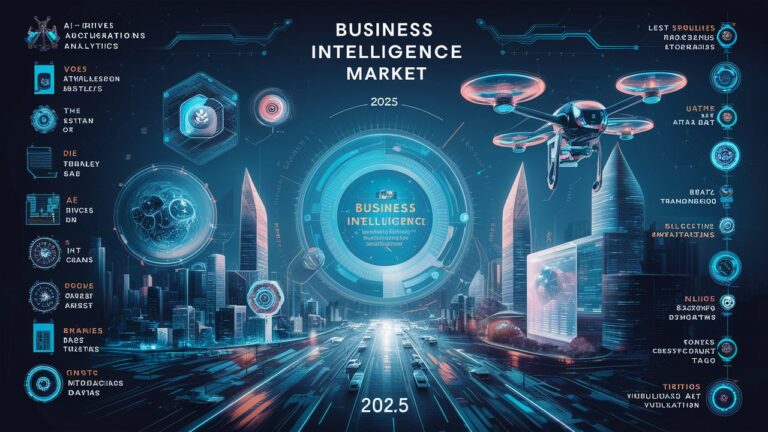Introduction
The global business intelligence market is experiencing unprecedented growth, projected to surge from $30.1 billion in 2024 to $116.25 billion by 2033, advancing at a robust 14.98% CAGR 15. This explosive expansion is fueled by the critical need for data-driven decision-making across industries, with organizations leveraging BI tools to transform raw data into strategic assets. As digital transformation accelerates, BI has evolved beyond basic reporting into sophisticated platforms integrating AI, machine learning, and predictive analytics, enabling businesses to optimize operations, uncover new opportunities, and maintain competitive agility. The market’s trajectory reflects a fundamental shift: data literacy is no longer a luxury but a core business competency, with 67% of the global workforce now accessing BI tools 4.
1. Market Size and Growth Projections
The BI market demonstrates remarkable momentum, with Fortune Business Insights projecting growth from $31.98 billion in 2024 to $63.20 billion by 2032 at an 8.9% CAGR 4, while Straits Research forecasts an even steeper ascent to $116.25 billion by 2033 15. This variance underscores differing methodologies but confirms massive expansion. Key catalysts include the exponential growth of data (projected at 175 zettabytes by 2025), cloud adoption, and democratization of analytics tools 13. Enterprises with >5,000 employees report >80% BI adoption rates, while the global average sits at 26%—indicating substantial headroom for growth 1. The convergence of scalable cloud infrastructure, AI integration, and rising data literacy is transforming BI from an IT function into an organizational imperative.
2. AI and Machine Learning Integration
AI and ML are revolutionizing BI capabilities, transitioning platforms from descriptive to prescriptive and predictive analytics. Microsoft Power BI’s AI integration, for instance, enables financial institutions to model market behavior and forecast stock performance, while retailers like Amazon leverage ML for demand forecasting and personalized marketing 16. These technologies automate data preparation, anomaly detection, and insight generation, reducing manual analysis time by up to 70%. According to PwC, AI could contribute $15.7 trillion to the global economy by 2030, with BI being a primary conduit 6. Embedding AI into BI workflows transforms reactive decision-making into proactive strategy—enabling businesses to anticipate trends, optimize inventories, and mitigate risks before they materialize.
3. Augmented Analytics
Augmented analytics uses AI, ML, and NLP to automate data insight generation, making advanced analytics accessible to non-technical users. By 2025, tools like Zoho Analytics 6.0 will automate 80% of data preparation, enabling marketers to generate campaign insights without data science expertise 56. This democratization drives efficiency: Retailers adjust inventory in real-time based on live customer behavior, while healthcare providers predict patient outcomes using automated pattern recognition 6. The global augmented analytics market is surging alongside the broader BI industry, expected to reach $33.3 billion by 2025 6. By abstracting technical complexity, augmented analytics shifts organizational focus from data processing to strategic action—turning every department into a data-driven unit.
4. Data Governance and Security
As data volumes explode, governance and security have ascended to top BI priorities. BARC’s 2024 survey reveals data security/privacy, data quality management, and governance as the #1–3 trends globally 2. Regulations like GDPR and CCPA compel enterprises to implement strict access controls, anonymization protocols, and ethical data usage frameworks. Poor data quality costs businesses $9.7 million annually (Gartner), while U.S. companies lose $3.1 trillion yearly due to inaccuracies 4. Solutions like ThoughtSpot’s AI-driven search and dbt Labs’ governance integrations help standardize metadata management and ensure compliance 46. Robust governance is no longer optional—it’s the bedrock of trustworthy analytics, minimizing regulatory risk while maximizing data utility.

5. Self-Service Business Intelligence
Self-service BI empowers non-technical users to conduct analyses via intuitive dashboards and drag-and-drop interfaces. The market for these tools is growing at a 14.90% CAGR (2025–2034), fueled by demand for agile decision-making 6. Platforms like Tableau and Power BI reduce IT dependency, allowing sales teams to track pipeline metrics or HR to analyze retention rates independently. 62% of organizations now deem self-service essential to data strategy, up from 54% in 2020 1. However, success requires balancing accessibility with governance: Low-code flexibility must coexist with data quality controls to prevent misinterpretation. Self-service BI turns data consumers into data creators—accelerating insight velocity while fostering a pervasive data culture.
6. Real-Time Analytics
Real-time analytics enables immediate response to market shifts by processing live data streams. Financial institutions use it for fraud detection, while retailers optimize dynamic pricing during demand spikes 6. This capability hinges on in-memory computing and stream processing engines, technologies projected to help the BI market reach $43 billion by 2028 (Zion Market Research) 6. Challenges include infrastructure costs and integration complexity—91.9% of organizations report value from data investments, but only 28% achieve real-time maturity 6. The shift from batch to streaming analytics represents a competitive frontier: Businesses acting fastest on live data capture unprecedented value.
7. Cloud-Based BI Solutions
Cloud deployment dominates the BI landscape due to its scalability, cost efficiency, and remote accessibility. North America leads with an 87% cloud adoption rate, followed by Asia (68%) and Europe (60%) 13. Vendors like Domo and Looker offer SaaS models that eliminate upfront hardware costs, particularly benefiting SMEs. Cloud BI’s flexibility supports hybrid architectures, allowing sensitive data to remain on-premise while analytics run in the cloud. As enterprises prioritize agility, cloud BI becomes the default—enabling seamless updates, global collaboration, and elastic resource allocation.
8. Regional Market Dynamics
- North America: Dominates (30.96% share) with hubs like Silicon Valley driving innovation. High cloud adoption (87%), strong AI investment, and sectors like healthcare using BI for patient analytics solidify its lead 14.
- Asia-Pacific: Fastest-growing region, fueled by India’s “Digital India” initiative, China’s big data investments, and SME adoption. Manufacturing and e-commerce sectors leverage BI for supply chain optimization 14.
- Europe: Germany leads in manufacturing BI (Industry 4.0), while the U.K. focuses on finance and real-time cloud analytics 1.
Regional disparities reflect varying digital maturity, but universal demand for actionable insights is converging markets toward cloud and AI-centric models.
9. Industry-Specific Adoption
- BFSI: Largest adopter (>25% market share), using BI for real-time fraud detection, risk modeling, and customer retention. Projects the highest growth by 2032 48.
- IT/Telecom: Leverages BI for network optimization and customer churn prediction. Leads in market revenue 4.
- Retail: Employs predictive analytics for inventory planning (e.g., Amazon) and personalized marketing 13.
- Healthcare: Adopting BI for patient outcome prediction and operational streamlining 1.
Vertical-specific solutions—like SYSPRO’s BI for manufacturing—are tailoring platforms to industry pain points, boosting ROI and adoption.
10. Challenges and Opportunities
Data security concerns and integration complexities remain barriers, particularly for industries handling sensitive information (e.g., healthcare) 14. However, emerging opportunities abound:
- Ethical AI Governance: Developing frameworks for bias-free algorithmic decision-making 3.
- Edge Analytics: Processing IoT data closer to source devices for faster manufacturing insights.
- Generative AI: Integrating tools like ChatGPT for natural language querying and automated report generation.
Balancing innovation with ethical stewardship will define next-generation BI leadership.
Conclusion
The business intelligence market is advancing toward an AI-driven, real-time, and democratized future. As cloud infrastructure matures and generative AI integrates deeper into platforms, BI will become increasingly conversational and accessible. Enterprises prioritizing data literacy training, ethical governance, and scalable architectures will capture outsized value—transforming data from a passive asset into an active competitive lever. With the Asia-Pacific region poised to lead growth and SMEs accelerating adoption, BI’s evolution promises to reshape organizational decision-making landscapes globally.
Frequently Asked Questions
Q1: What is driving the rapid growth of the BI market?
A: Key drivers include exploding data volumes (175ZB by 2025), demand for data-driven decisions (linked to 5% higher productivity), cloud adoption, and AI integration 14.
Q2: Which industries benefit most from BI?
A: BFSI (fraud detection, risk management), retail (demand forecasting), healthcare (patient analytics), and manufacturing (supply chain optimization) are top adopters 14.
Q3: How does self-service BI transform organizations?
A: It empowers non-technical users to generate insights, reducing IT bottlenecks and accelerating decision-making. 62% of firms now consider it essential 16.
Q4: What are the biggest barriers to BI adoption?
A: Data security risks, poor data quality (costing firms $9.7M annually), and integration challenges with legacy systems 14.
Q5: Will cloud-based BI dominate on-premise solutions?
A: Yes, cloud BI is growing fastest due to scalability and cost benefits. North America leads with 87% adoption 13.
